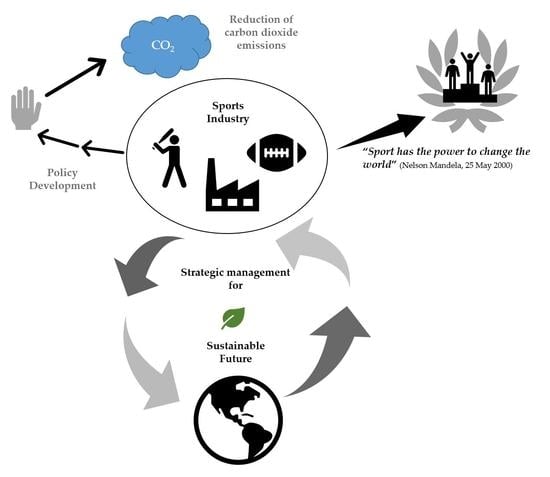Carbon Dioxide Emissions Research and Sustainable Transportation in the Sports Industry
Abstract
1. Introduction
2. Environmental Efforts
3. Carbon Dioxide Sources
4. Sporting Events
5. Sports Facilities
6. Transportation
7. Problem Indication
8. Solutions
Funding
Conflicts of Interest
References
- Mann, M.E.; Rahmstorf, S.; Kornhuber, K.; Steinman, B.A.; Miller, S.K.; Coumou, D. Influence of anthropogenic climate change on planetary wave resonance and extreme weather events. Sci. Rep. 2017, 7, 45242. [Google Scholar] [CrossRef] [PubMed]
- Dosumu, A.; Colbeck, I.; Bragg, R. Greenhouse gas emissions as a result of spectators travelling to football in England. Sci. Rep. 2017, 7, 6986. [Google Scholar] [CrossRef] [PubMed]
- Triantafyllidis, S.; Ries, R.J.; Kaplanidou, K.K. Carbon Dioxide Emissions of Spectators’ Transportation in Collegiate Sporting Events: Comparing On-Campus and Off-Campus Stadium Locations. Sustainability 2018, 10, 241. [Google Scholar] [CrossRef]
- United Nation Environmental Program (2018). Sport and the Environment. Available online: http://www.unep.org/sport_env/ (accessed on 23 September 2018).
- United States Environmental Protection Agency. Greenhouse Gas. (GHG) Emissions. Available online: https://www.epa.gov/ghgemissions (accessed on 8 August 2018).
- Chard, C.; Mallen, C. Examining the linkages between automobile use and carbon impacts of community-based ice hockey. Sport Manag. Rev. 2012, 15, 476–484. [Google Scholar] [CrossRef]
- Schmidt, C.W. Putting the earth in play: Environmental awareness and sports. Environ. Health Perspect. 2006, 114, 286–295. [Google Scholar] [CrossRef] [PubMed]
- Collins, A.; Cooper, C. Measuring and managing the environmental impact of festivals: The contribution of the Ecological Footprint. J. Sustain. Tour. 2017, 25, 148–162. [Google Scholar] [CrossRef]
- International Olympic Committee. Manual on Sport and the Environment. Available online: http://www.olympic.org/Documents/Commissions_PDFfiles/manuel_sport_environment_en.pdf (accessed on 12 September 2018).
- Kellison, T.B.; Mondello, M.J. Organizational perception management in sport: The use of corporate pro-environmental behavior for desired facility referenda outcomes. Sport Manag. Rev. 2012, 15, 500–512. [Google Scholar] [CrossRef]
- Casper, J.M.; Pfahl, M.E.; McCullough, B. Intercollegiate sport and the environment: Examining fan engagement based on athletics department sustainability efforts. J. Issues Intercoll. Athl. 2014, 7, 65–91. [Google Scholar]
- Babiak, K.; Trendafilova, S. CSR and environmental responsibility: Motives and pressures to adopt green management practices. Corp. Soc. Responsib. Environ. Manag. 2011, 18, 11–24. [Google Scholar] [CrossRef]
- Babiak, K.; Wolfe, R. Determinants of corporate social responsibility in professional sport: Internal and external factors. J. Sport Manag. 2009, 23, 717–742. [Google Scholar] [CrossRef]
- McCullough, B.P. The Recycling Intentions of Sport Spectators: A Theory of Planned Behavior Approach. Ph.D. Thesis, Texas A & M University, College Station, TX, USA, May 2011. [Google Scholar]
- McCullough, B.P.; Kellison, T.B. Routledge Handbook of Sport and the Environment; Routledge Handbooks Online: New York, NY, USA, 2018; ISBN 9781138666153. [Google Scholar]
- Schmied, M.; Hochfeld, C.; Stahl, H.; Roth, R.; Arbruster, F.; Turk, S.; Friedl, C. Green Champion in Sport and Environment: Guide to Environmentally-Sound Large Sporting Events; Federal Ministry for the Environment, Nature Conservation and Nuclear Safety and German Olympic Sports Confederation (DOSB), Division Development of Sports: Frankfurt, German, 2007. [Google Scholar]
- Triantafyllidis, S.; Kaplanidou, K. Health and self- motivation as predictors of marathon runners’ pro-environmental behaviors. In Proceedings of the North American Society for Sport Management Conference, Denver, CO, USA, 30 May–3 June 2017. [Google Scholar]
- Triantafyllidis, S.; Kaplanidou, K. Olympus mountain marathon participants and voluntary carbon offsetting intentions. In Proceedings of the North American Society for Sport Management Conference, Halifax, NS, Canada, 5–9 June 2018. [Google Scholar]
- Triantafyllidis, S. Sense of Place and Pro-Environmental Behavior in Beach Volleyball. Ph.D. Thesis, University of Florida, Gainesville, FL, USA, August 2018. [Google Scholar]
- Chernushenko, D. Greening Our Games: Running Sports Events and Facilities That Won’t Cost the Earth; Centurion Publishing & Marketing: Ottawa, ON, Canada, 1994; ISBN 0969757158. [Google Scholar]
- Collins, A.; Roberts, A.; Munday, M. The Environmental Impacts of Major Cycling Events: Reflections on the UK Stages of the Tour de France; Cardiff University: Cardiff, UK, 2012; Available online: http://orca.cf.ac.uk/53325/1/Tour-de-France.pdf (accessed on 2 May 2016).
- Dolf, M.; Teehan, P. Reducing the carbon footprint of spectator and team travel at the University of British Columbia’s varsity sports events. Sport Manag. Rev. 2015, 18, 244–255. [Google Scholar] [CrossRef]
- Federation International Football Association. Available online: https://www.fifa.com/ (accessed on 15 September 2018).
- Major League Baseball. MLB Greening Program. Available online: http://web.mlbcommunity.org/index.jsp?content=programs&program=team_greening_program (accessed on 1 September 2018).
- Crossman, M. When the party’s over. Sport. News 2008, 37, 232. [Google Scholar]
- University Athletic Association. Available online: http://uaasports.info/landing/index (accessed on 12 September 2018).
- Mihyeon, J.C.; Amekudzi, A. Addressing sustainability in transportation systems: Definitions, indicators, and metrics. J. Infrastruct. Syst. 2005, 11, 31–50. [Google Scholar] [CrossRef]
© 2018 by the author. Licensee MDPI, Basel, Switzerland. This article is an open access article distributed under the terms and conditions of the Creative Commons Attribution (CC BY) license (http://creativecommons.org/licenses/by/4.0/).
Share and Cite
Triantafyllidis, S. Carbon Dioxide Emissions Research and Sustainable Transportation in the Sports Industry. C 2018, 4, 57. https://doi.org/10.3390/c4040057
Triantafyllidis S. Carbon Dioxide Emissions Research and Sustainable Transportation in the Sports Industry. C. 2018; 4(4):57. https://doi.org/10.3390/c4040057
Chicago/Turabian StyleTriantafyllidis, Stavros. 2018. "Carbon Dioxide Emissions Research and Sustainable Transportation in the Sports Industry" C 4, no. 4: 57. https://doi.org/10.3390/c4040057
APA StyleTriantafyllidis, S. (2018). Carbon Dioxide Emissions Research and Sustainable Transportation in the Sports Industry. C, 4(4), 57. https://doi.org/10.3390/c4040057




